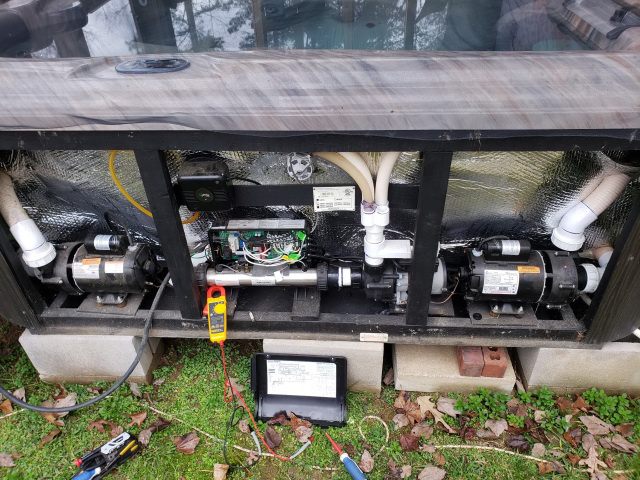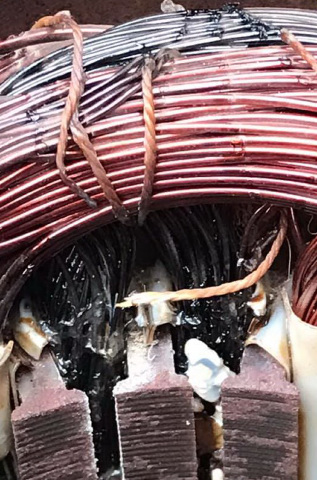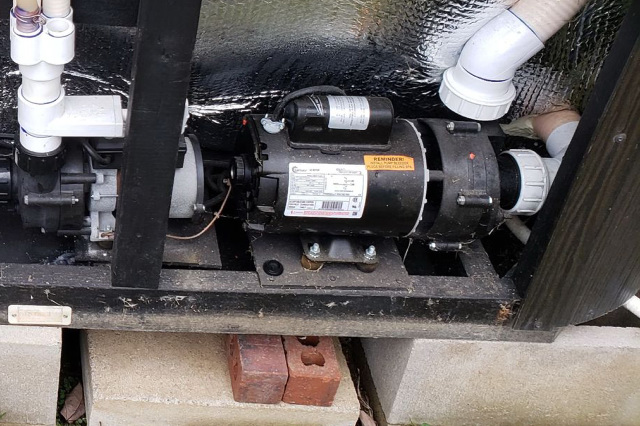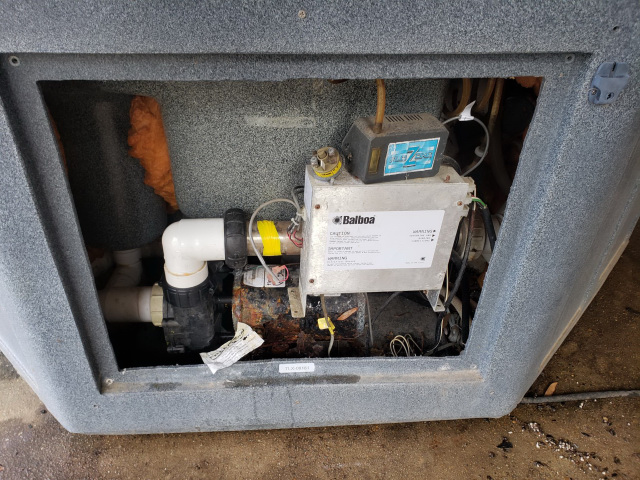Do you notice that your hot tub pump seems noisier than usual? Curiosity can quickly turn into dread at potentially having to replace your spa’s pump. So, why could your hot tub pump be louder than normal?
The most common reasons your hot tub is noisy are:
- worn bearings
- worn impeller
- trapped air (airlock)
- blockages in lines or filter
- faulty startup capacitor
Before jumping into how to fix (and quieten) your noisy pump, let’s look at common reasons and what noises are typical for your tub’s pump.

Article Contents
Common Noises Your Pump Could be Making & Why
The most common noises you’ll encounter with your hot tub pump are loud humming or loud grinding/screeching noises. There are a variety of reasons why the pump will make these noises.
Humming
A loud humming noise could indicate different issues depending on whether the pump works or not. If your spa’s pump is humming but still working well, it may be that there is air in the system or the bearings are worn.
However, if your tub isn’t working while loudly humming, it can mean something more serious. Causes include a faulty motor run (start) capacitor, a lock-up in the motor shaft, or an incorrect input voltage.
Loud Grinding/Screeching
If your hot tub pump makes this noise, the bearings are the most likely culprit. They are probably wearing out. Aside from bearings, a grinding/screeching noise could indicate a problem with the impeller.

Related Reading: How to Hide Pool Equipment in Your Yard
How Noisy Should a Hot Tub Pump Be?
Most hot tubs produce between 41 and 67 dB of noise. So if your hot tub pump is generating noise louder than this range, there’s likely something wrong.
For reference, 41 dB is the usual noise level of a library, whereas 67 dB is the noise level of running your vacuum.
One thing to be aware of is the time of day you notice your hot tub pump noise. Things tend to sound louder at night as the world quietens for the evening. But, if you think something is wrong with your spa, it could be worth getting a decibel meter to check how noisy your tub’s pump is. You can get one here:
- Measures volume of noise
- Super easy and simple to use
- All readings are measured in dBA
How to Troubleshoot and Fix a Noisy Hot Tub Pump
Before you can quieten your hot tub pump, you need to find the source/cause of the noise. The following steps will help you troubleshoot possible causes and how to quieten them.
1. Check the Pump is Mounted Correctly
An improperly placed pump not only causes it to become much louder but can wear down unions, bolts, and screws quickly. Poor mounting can result in excessive vibrations.
How your pump is mounted depends on the type of hot tub you have. Above-ground hot tubs usually have the pump located behind one of the side panels. Inground spas or hot tubs usually have a separate location for the pump and heater.
- Check the pump base to ensure it is on a hard, flat surface. An uneven surface will increase any noise as the pump moves while working.
- If your hot tub pump sits on a mount, ensure that the mounting screws are tightly secured. Loose screws can amplify pump noise and cause vibrations.
- Consider the location of the pump. Is it close to the walls, or is it enclosed? Is it sitting on gravel? This could contribute to noise.

Check out our What to Use for Pool Equipment Pad & Best Practices to get the most out of your hot tub equipment without the noise.
2. Check System For Airlock
If your hot tub’s pump has been working perfectly but makes a humming noise, an airlock could be the cause of a noisy pump. An airlock is when there is trapped air in the lines or pipes of your hot tub’s system. Here’s what to do if you suspect this:
- Turn off the system (ideally from the circuit breaker) before attempting to resolve the trapped air.
- Find the pump’s collar (unions) and loosen it. Doing this should help release the trapped air – you’ll hear the air release if this is where it’s trapped. Ensure you don’t use excessive force when securing unions and bolts to avoid cross-threading and damage.
- Also, try loosening and removing the heater hoses. If there is trapped air, you’ll hear the air release and water will start running out of them.
- Now switch the tub back on and see how it runs.
Tip: To avoid airlock or trapped air, ensure that the water level isn’t too low. The water must cover the jets and filter housing to prevent air sucking into the system.
3. Keep the Filter Clean
A dirty filter will increase the pressure the pump has to work. Regularly clean your spa’s filter and replace it every 12 months.
- After turning off the hot tub’s system, remove the filter from its housing and inspect it.
- You can use a garden hose to remove trapped dirt from the filter, ensuring that you get into each individual filter pleat. Or use this easy-to-use filter cleaner that is attached to your hose. This will give the filter a good clean between the pleats.
- Do this every 1-2 weeks to keep the filter working well.
- Then, every 2-3 months, replace the hot tub water and soak the filter in a filter cleaning solution. Allow it to soak for at least 12 hours and thoroughly dry afterward. A damp filter is the perfect breeding ground for bacteria.
- Saves time & speeds up filter cleaning
- Ensures no damage to filters
- Compatible with most standard pool filters
4. Check for Obstructions
Sometimes there can be a blockage in the impeller or the pump or in the lines. This can cause a pump to strain and make additional noise. Here’s how to check this:
- Compare the ideal pressure gauge range with what your pump is reading. If you see a considerably higher reading on yours, you may have an obstruction putting extra pressure on the pump.
- First, turn everything off (from the circuit breaker is ideal, if possible). Located the motor and try to turn the shaft, with long nose pliers, which is between the motor and the impeller. If it doesn’t turn easily either the impeller is blocked or the pump’s bearings are seized.
- Also, check the filter basket. Remove it to check for caught debris or leaves around the intake and outlet ports of the basket housing.
- Clean any leaves or dirt from the basket before returning it to its housing.
If the pump is still loud, it’s time to inspect the pump for issues.
5. Check Impeller and Bearings
Bearings that are seized or on the way out will cause a noisy hot tub pump. Same with the impeller, if it isn’t freely spinning, it will make excessive noise.

Here’s how to check your pump impeller and bearings.
- Before doing anything, switch off the filter system (ideally from the electrical breaker).
- Locate your hot tub’s pump. Above-ground hot tubs will have the pump behind one of the side panels. Inground tubs could have the equipment located away from the tub.
- Shut off the valves in the lines running to the pump so when you remove it, water won’t flow.
- Loosen the unions of the pump and disconnect the power. Take out the pump.
- With the pump removed, take off the impeller.
- Inspect the impeller blades. If the blades (and the impeller body) are in good condition and spin freely, it’s probably OK.
Now turn the pump shaft by hand. It should feel like it spins freely. If it’s stuck or difficult to turn, the bearings are probably gone. You may also notice corrosion near the bearings which indicates a leak and is probably the reason why the bearings are faulty. - Replace the pump, impeller, or bearings if you have any of the above problems. See below for instructions.
6. Check the Startup Capacitor
The startup capacitor is responsible for giving the hot tub motor a big kick or power to get the motor to turn. If the capacitor is faulty, the pump may make a loud humming noise instead of turning. It may also intermittently start.
To check this, switch off the power. Next, make sure the capacitor has been discharged. If you’re not sure how to do this, you probably shouldn’t be attempting to fix the issue.
Now measure the capacitance with a multimeter. Sometimes this test isn’t reliable and you may find it easier to swap the capacitor for a new one. If it works, the job is done. If not, you’ll need to continue troubleshooting.
We have a full article on how to check your startup capacitor.
Related Reading: How Long Should I Run My Hot Tub Filter?
How to Replace a Hot Tub Pump
If none of the above troubleshooting steps work, it might be time to replace the pump. And luckily, it is something that you can do yourself.
But, if you are unsure of any aspect of pump replacement, consider hiring a professional. Working with wiring and water can be a deadly combination
1. Turn Off Hot Tub
Before dealing with the pump replacement, turn off your hot tub from its power source (circuit breaker).
2. Find Your Pump Replacement
Most pumps will have a model number along with other vital info such as voltage, amperage, and plumbing stuck on the outside of the pump.
Either get a new version of the same model or shop for an alternative. Though, stick to reputable brands like AquaFlow or Waterway to ensure you have a quality pump replacement.
3. Loosen Pipe Unions
Find the intake and outlet pipes that connect to the pump and loosen the unions on each pipe.
4. Loosen Pump Housing
Once the collars are loose, you can tackle the pump motor housing by unscrewing the bolts on the pump house base.
5. Disconnect Wires
Before starting, take a photo of the wiring so you know where they go.
There are usually three wires plus a ground wire to disconnect – the power cord and ground wire. First, open the hot tub control box to expose the wires. Find the power cord by tracing it from the pump to the electric control box. And do the same with the ground wire (it should be a copper/green wire near the top of the motor).
Depending on the control box, there may be a strip of metal securing the wires/cords into the box. Remove that with a screwdriver, releasing the wires. Then unclip the power cord plug from the circuit board in the control box, pulling it free.
6. Remove Pump
After disconnecting the wires from the control box, you can gently work the pump out, avoiding snagging wires.
7. Move Wires to New Pump
The ground wire is the easiest to move first. Simply unscrew it from the old pump and transfer it to that same spot on the new model, securing it firmly into place.
To swap the power cord, first, you need to remove the rear cap of the old pump to expose the power cord underneath.
Unscrew the new pump’s rear cap, and, once all the wires are secured correctly, simply screw the rear cap back on.
8. Clean Up Pump Area
Before you attach the new pump to its housing, now is an excellent time to inspect the housing area. First, ensure that everything (piping, gaskets, vibration dampening mounts) is still in good condition and remove trapped dirt and debris while you have this extra free space.
- Universal design
- Reduces noise/vibrations on pumps & pool equipment
- Easy to install
Also, check for any water leaks. Water leaks can cause circuit breakers to trip and all sorts of electrical problems in hot tubs.
9. Put Pump Into Place
Being mindful of wires and piping, place the pump back into position and finger-tighten it to the base. Doing this will give you a little wiggle room to work with when reattaching the intake and outlet unions.
10. Secure Unions
Regardless of whether you’re replacing the union gaskets or not, make sure to thoroughly lube up the inner union to help create an even tighter seal. Reapply the lube to the gaskets if you’re not replacing them too.
Tightly secure both unions to the pump body before reattaching wires.
11. Reattach Wires
Simply reattach the ground wire to the control box, screwing it tightly. Then, clip the power cord into the control box before securing the control box cover back on.
12. Refill Hot Tub
Once everything is back in its place, you can fill the hot tub with water and work at balancing the chemistry. As the hot tub is filling, check the pump for possible leaks and tighten it where needed.
Heating a hot tub can take hours and interrupt your craving for a dip. Check out our guide, How Long Does It Take to Heat a Hot Tub? (and Tips for Faster Heating) for tricks on how to speed up heating time.
Tips to Maintain a Quiet Hot Tub Pump
Some tips on how to maintain a quiet hot tub pump include:
- Regularly clean your hot tub’s filter
- Swap out pump mount for anti-vibration mats or insulating material
- Regularly inspect for worn gaskets, impeller, or bearings
- Enclose the pump to dampen noise (while keeping good ventilation)
- Make sure connections (unions, screws, bolts) are all securely tightened
Related Reading: Why Your Pool Pump is Noisy and How to Fix It (Quiet it)
Final Thoughts
A loud hot tub pump doesn’t help the relaxing impression hot tubs give. Luckily, most causes of a noisy pump are easily fixable and will have you back relaxing in your spa in no time.
And, if it comes to needing to replace the pump, our guide above will help you cut the stress and cost of having to hire a professional to do the job.
Related Reading: What to Do About Your Neighbor’s Noisy Pool Pump & Your Rights




